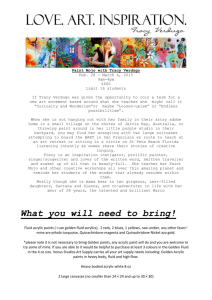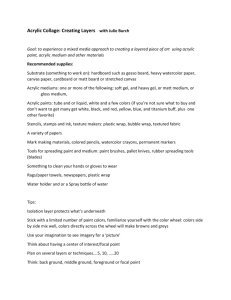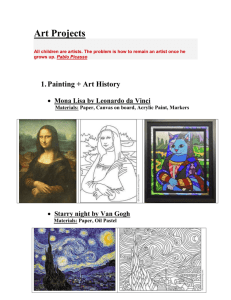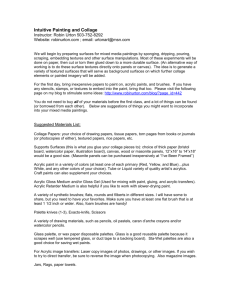e-PS, 2014, ISSN: 1581-9280 web edition ISSN: 1854-3928 print edition e-Preservation Science (e-PS)
advertisement
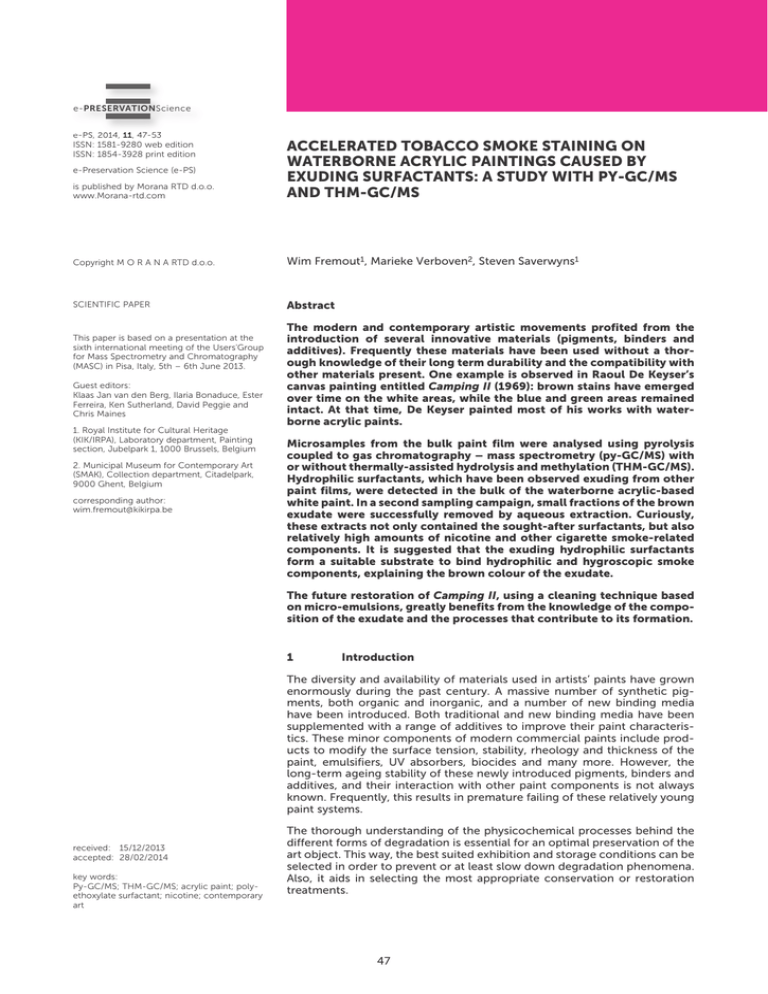
e-PRESERVATIONScience e-PS, 2014, 11, 47-53 ISSN: 1581-9280 web edition ISSN: 1854-3928 print edition is published by Morana RTD d.o.o. www.Morana-rtd.com ACCELERATED TOBACCO SMOKE STAINING ON WATERBORNE ACRYLIC PAINTINGS CAUSED BY EXUDING SURFACTANTS: A STUDY WITH PY-GC/MS AND THM-GC/MS Copyright M O R A N A RTD d.o.o. Wim Fremout1, Marieke Verboven2, Steven Saverwyns1 SCIENTIFIC PAPER Abstract e-Preservation Science (e-PS) This paper is based on a presentation at the sixth international meeting of the Users'Group for Mass Spectrometry and Chromatography (MASC) in Pisa, Italy, 5th – 6th June 2013. Guest editors: Klaas Jan van den Berg, Ilaria Bonaduce, Ester Ferreira, Ken Sutherland, David Peggie and Chris Maines 1. Royal Institute for Cultural Heritage (KIK/IRPA), Laboratory department, Painting section, Jubelpark 1, 1000 Brussels, Belgium 2. Municipal Museum for Contemporary Art (SMAK), Collection department, Citadelpark, 9000 Ghent, Belgium corresponding author: wim.fremout@kikirpa.be The modern and contemporary artistic movements profited from the introduction of several innovative materials (pigments, binders and additives). Frequently these materials have been used without a thorough knowledge of their long term durability and the compatibility with other materials present. One example is observed in Raoul De Keyser’s canvas painting entitled Camping II (1969): brown stains have emerged over time on the white areas, while the blue and green areas remained intact. At that time, De Keyser painted most of his works with waterborne acrylic paints. Microsamples from the bulk paint film were analysed using pyrolysis coupled to gas chromatography – mass spectrometry (py-GC/MS) with or without thermally-assisted hydrolysis and methylation (THM-GC/MS). Hydrophilic surfactants, which have been observed exuding from other paint films, were detected in the bulk of the waterborne acrylic-based white paint. In a second sampling campaign, small fractions of the brown exudate were successfully removed by aqueous extraction. Curiously, these extracts not only contained the sought-after surfactants, but also relatively high amounts of nicotine and other cigarette smoke-related components. It is suggested that the exuding hydrophilic surfactants form a suitable substrate to bind hydrophilic and hygroscopic smoke components, explaining the brown colour of the exudate. The future restoration of Camping II, using a cleaning technique based on micro-emulsions, greatly benefits from the knowledge of the composition of the exudate and the processes that contribute to its formation. 1 Introduction The diversity and availability of materials used in artists’ paints have grown enormously during the past century. A massive number of synthetic pigments, both organic and inorganic, and a number of new binding media have been introduced. Both traditional and new binding media have been supplemented with a range of additives to improve their paint characteristics. These minor components of modern commercial paints include products to modify the surface tension, stability, rheology and thickness of the paint, emulsifiers, UV absorbers, biocides and many more. However, the long-term ageing stability of these newly introduced pigments, binders and additives, and their interaction with other paint components is not always known. Frequently, this results in premature failing of these relatively young paint systems. received: 15/12/2013 accepted: 28/02/2014 key words: Py-GC/MS; THM-GC/MS; acrylic paint; polyethoxylate surfactant; nicotine; contemporary art The thorough understanding of the physicochemical processes behind the different forms of degradation is essential for an optimal preservation of the art object. This way, the best suited exhibition and storage conditions can be selected in order to prevent or at least slow down degradation phenomena. Also, it aids in selecting the most appropriate conservation or restoration treatments. 47 www.e-PRESERVATIONScience.org The exuding surfactants and other hydrophilic components that are dragged along are seen to form semicrystalline rounded crystals at the surface, but sometimes form patchy or even complete surface layers. This can lead to visual changes in gloss or enhanced dirt pick-up5. The brown stains on the white areas in De Keyser’s Camping II visually deviate from the described semicrystalline or matt surface effects observed in PEO surfactant exudates, but a relationship cannot be excluded. In this paper, the exact nature of the brown stains and reason for their formation are determined. To attain these goals, samples from the affected and unaffected paints, and the brown exudate are collected and analysed with py-GC/MS. To improve the detection of compounds with labile carboxylic acids, also THM-GC/MS is done on the bulk paint samples. In THM-GC/MS, these carboxylic acids are simultaneously converted into methyl esters and pyrolysed. Finally, the initial stages of a restoration campaign in the near future is described. 2 Experimental Figure 1. Camping II by Raoul De Keyser, with detail of the brown stains and sample locations: 1 white paint sample; 2 blue paint sample; 3 and 4 aqueous extracts. 2.1 Samples One particular case is the inexplicable brown stains on the canvas painting entitled Camping II (1969, figure 1), made by the Belgian abstract painter Raoul De Keyser (1930-2012). It is well-known that he used waterborne acrylic paints up until the mid-1970s, when he switched to oil paints. The brown stains have flow-like patterns and are only observed in the white painted areas. To develop a suitable conservation strategy for this valuable work, it was imperative to identify the components that make up these brown stains, the processes that causes them to occur in the purported acrylic white paints, and why the other colours do not seem to be affected. For the determination of the pigments, binding media and additives, two microsamples were collected from the affected white and the unaffected blue painted areas: small fragments were scraped off at the side edges of the painting by using an ophthalmic scalpel. In a second phase, two extracts from the brown stains were collected following a protocol described by Ormsby5: 50 µL milli-Q water was gently pipetted onto the paint surface and left in contact with the stain for two minutes (figure 2). Afterwards, the drops of water were carefully collected using a micropipette. Prior to py-GC/MS analysis, the water was evaporated using a vacuum centrifuge. The stability, degradation and water-sensitivity of waterborne acrylic paints (or acrylic emulsion paints) have been extensively studied and published in recent literature1–12. This type of artists’ paint has been commercially available since the late 1950s and is based on copolymers of the relatively hard methylmethacrylate (MMA) and softer ethyl acrylate (EA, mainly in early formulations), n-butyl acrylate (nBA, largely replaced EA in the late 1980s) or 2-ethyl hexyl acrylate (2EHA, in more recent formulations)12,13. Extraction with a drop of water Many of the documented problems, however, are related to the surfactants that are used to suspend (“emulsify”) the acrylic copolymers into the aqueous medium. In most cases non-ionic polyethoxylatebased surfactants (PEO) have been used, which are known to potentially migrate to the film surface through complex mechanisms involving water evaporation, interfacial tension reduction, diffusion and capillary forces and are influenced by several internal and external factors3,5,6. An extensive review of existing scientific research on this topic is given by Ormsby and Learner6. Evidently, the type and quantity of the surfactant play a decisive role, such as the length of the PEO-chains (the longer these are, the more hydrophilic and thus the more likely they will exude), as well as the copolymer blend and the quantity of acid monomer present. After extraction Figure 2. Aqueous extraction, locally removing the brown stains. 2.2 Instrumentation The py-GC/MS instrument consists of a Pyromat Curie-point pyrolysis unit (GSG Meß- und Analysengeräte) interfaced to a TraceGC Ultra gas chromatograph (Thermo) equipped with a SLB-5ms capillary column (Supelco; 20 m x 0.18 mm ID x 0.18 µm film thickness), coupled to a PolarisQ ion trap mass spectrometer (Thermo). The paint samples and dried extracts are dissolved and/or dispersed in 10 µL of either pure methanol, or 2.5% tetramethylammonium hydroxide (TMAH) in methanol in case of THM-GC/MS, and 4 µL of the resulting solution is dropped onto the tip of a Curie- Tobacco smoke staining on acrylics, e-PS, 2014, 11, 47-53 48 © by M O R A N A RTD d.o.o. the figure). These are characteristic break-down products of poly(ethyl acrylate-co-methyl methacrylate) or p(EA-MMA), which is typical for early formulations of acrylic emulsion paints between WWII and the mid1980s13. It was and is available under different commercial names, such as Plextol B-500 (Röhm), Primal AC-234, AC-634, AC-33 and AC-22 (Rohm & Haas). A number of minor components can be identified as characteristic for paint additives. Without methylation, these are dibutyl phthalate (RT 18.32 min), p-tert-octyl phenol (RT 11.28 min) and a di-tert-butyl phenol (RT 9.39 min). Di-n-butyl phthalate (DnBP) is a common plasticiser, while p-tert-octyl phenol is a pyrolysis product of octyl phenyl polyethoxy ethanol7, a common PEO surfactant to suspend the acrylics in the aqueous medium. It is commercially available under the name Triton (e.g. Triton X-405 and X-305). The ditert-butyl phenols are a group of UV absorbers and antioxidants; the isomers share the same mass spectrum and cannot be distinguished. 3,5-di-tert-butyl phenol, for example, is known to be present in the Plextol product range (e.g. Plextol D-498)7. point wire. After drying, the wire is introduced in the pyrolysis unit, which is maintained at 250 °C. Pyrolysis is set at 625 °C (determined by the wire used) for 10 s. The split injector is at 250 °C with a split ratio of 8:1. The GC oven programme was 50 °C for 1 min, then ramped at 50 °C/min to 100 °C, at 5 °C to 180 °C and at 10 °C/min to 320 °C, which is maintained for 5 min. The mass spectrometer records the m/z 35-500 range (scan time 0.50 s) in positive electron impact modus. For completeness, the paint samples are analysed with dispersive micro-Raman spectroscopy mainly for pigment identification, and with FTIR microscopy, which generally gives a general characterisation of the binding media. The micro-Raman spectrometer is a Renishaw Invia equipped with a 785 nm diode laser excitation source and a direct-coupled microscope with 50x objective lens. A Bruker Vertex 70 FTIR system is used, equipped with a Hyperion 3000 microscope in transmission modus and using a diamond cell. 3 Results 3.1 White paint sample With methylation using TMAH, the methyl esters of hexadecanoic (palmitic) acid, octadecanoic (stearic) acid and dehydroabietic acid (DHA) are detected (respectively at RT 17.81, 20.83 and 22.96 min). The former two are typical components of animal and vegetal oils, while the latter is a marker for colophony. However, other crucial markers for oils and colophony The pigments in the white paint were identified with micro-Raman spectroscopy (figure 3) as titanium white (TiO2; rutile form) and barium sulphate (BaSO4), which is often observed as a filler in contemporary paints. In addition, the FTIR spectrum (figure 4) showed the presence of acrylates in the binding medium. The highest correlation in our FTIR-library was poly(ethyl acrylate), but closely followed by other acrylates. Absorbane (arb. units) white paint sample Py-GC/MS was subsequently used to achieve a more precise and reliable identification, as well as characterise the additives in the white paint sample. Pyrograms are recorded without and in the presence of the methylation agent TMAH during pyrolysis (figure 5). The pyrogram of the regular pyrolysis is dominated by sesquimeric (one and a half monomers; retention time (RT) 4.71 and 5.23 min), dimeric (RT 5.16 and 6.03 min) and trimeric (RT 14.45, 15.00, 16.08 and 16.42 min) combinations of ethyl acrylate (EA) and methyl methacrylate (MMA). The monomers are coeluting, but can be distinguished by using selective ion plotting of their respective molecular ions (EA with m/z 55 at 1.14 min and MMA with m/z 69 at 1.20 min; not shown in blue paint sample poly(vinyl acetate) Relative abundance (arb. units) Wavenumber (cm-1) Figure 4. FTIR spectra of the white paint sample, identified as containing an acrylic binder, and the blue paint sample, identified as containing a polyvinyl acetate binder. white paint sample Intensity (arb. unit) poly(ethyl acrylate) titanium white (rutile) barium sulphate blue paint sample Time (min) Figure 5. Py-GC/MS and THM-GC/MS pyrograms of the white paint sample. Identified components: 1 EA monomer; 2 MMA monomer; 3 EA-MMA sesquimer; 4 EA-MMA dimer; 5 EA-EA sesquimer; 6 EA-EA dimer; 7 EA-EA-MMA trimmers; 8 EA-EA-EA trimer; DtBPh di-tertbutyl phenol; DnBP di-n-butyl phthalate; OP p-tert-octyl phenol; DMP dimethyl phthalate; P ME hexadecanoic acid methyl ester, S ME octadecanoid acid methyl ester, DHA ME dehydroabietic acid methyl ester. pigment blue 15:x Raman shift (cm-1) Figure 3. Raman spectra of the white paint sample, identified as containing a mixture of titanium white (rutile) and barium sulphate, and the blue paint sample, identified as containing pigment PB15:x. Tobacco smoke staining on acrylics, e-PS, 2014, 11, 47-53 49 www.e-PRESERVATIONScience.org are absent or below detection limits, suggesting that hexadecanoic acid, octadecanoic acid and DHA are added separately: their salts are often used in contemporary paints to optimise certain characteristics of the paints (rheology, gloss, etc.). In the presence of TMAH, DnBP is converted into dimethyl phthalate (DMP; RT 8.17 min). 3.2 min) contradicting the broad band of non-resolved peaks observed by Learner13. The monomers, sesquimers, dimers and trimers of p(EA-MMA) are present in the blue paint sample as well, although at a much lower abundance compared with the white paint sample. Without selective ion plotting only the most intense peak, that of the EA-EAEA trimer, can be observed in the top spectrum of figure 6. This suggests the blue paint has a small fraction of the acrylic white paints mixed in to attain a slightly lighter blue hue. Titanium white and barium sulphate are weak Raman scatterers compared to PB15:x, which exhibits a high Raman response; this explains why these were not observed with Raman spectroscopy in the blue mixture. Blue paint sample The pigment in the blue paint sample was identified as phthalocyanine blue using Raman microscopy (figure 3). Several forms of phthalocyanine blue exist, jointly called Pigment Blue 15:x (PB15:x), where x can be 0, 1, 2, 3, 4 or 6 corresponding to the specific crystalline form. Whether the exact form can be determined using Raman spectroscopy is a controversial topic14–16, and is therefore omitted here. FTIR analysis of the sample indicates the presence of poly(vinyl acetate) (PVAc) as binder (figure 4). With methylation using TMAH, the same additives were found as in the white paint sample: the methyl esters of hexadecanoic acid, octadecanoic acid and DHA. The relatively high amounts of DMP are the result of methylation of the relatively high amounts of DnBP that were already observed in the non-methylated pyrogram. The binder was confirmed with py-GC/MS, where, although not completely resolved, its typical pyrolysis products13 acetic acid and benzene are observed. Figure 6 shows both components using selective ion plotting (m/z 43+45+60 for acetic acid with RT 0.88 min, m/z 78 for benzene with RT 1.03 min). Styrene and phenyl glyoxal (resp. RT 2.00 and 2.35 min) seem to be related compounds through incomplete pyrolysis (in comparison with Learner13). PVAc gives rise to hard and brittle paint layers unless high amounts (up to 20%) of plasticisers are added. DnBP is a typical external plasticiser for PVAc13, but is known to migrate out of the paint film over time and thus slowly increase brittleness, while creating a tacky surface. That is why often internal plasticisers that copolymerise within the PVAc were introduced in the 1960s13. In this case a vinyl versatate resin (VeoVa) seems to have been added, although only a single peak is observed (RT 5.13 3.3 Aqueous extracts of the brown stains Relative abundance (arb. units) Relative abundance (arb. units) Even though the brown stains were locally removed as a consequence of the aqueous extraction procedure (figure 2), the extracts contained very little material detectable by py-GC/MS. This suggests that the brownish layer is extremely thin. After evaporation and redissolving in ethanol, the complete sample was introduced in the pyrolysis unit (figure 7). Relative abundance (arb. units) Time (min) Figure 7. Py-GC/MS pyrogram of the aqueous extract of a brown stain. Identified components: N nicotine; Ntyr nicotyrine; TCEP tri(2chloroethyl)phosphate; OP p-tert-octyl phenol. Time (min) Figure 6. Py-GC/MS and THM-GC/MS pyrograms of the blue paint sample. Identified components: VeoVa vinyl versatate; DtBPh di-tertbutyl phenol; DnBP di-n-butyl phthalate; AcOH acetic acid; Bz benzene; St styrene; PhG phenyl glyoxal; DMP dimethyl phthalate; P ME hexadecanoic acid methyl ester, S ME octadecanoic acid methyl ester, DHA ME dehydroabietic acid methyl ester. nicotine nicotyrine m/z Figure 8. Mass spectra of nicotine and nicotyrine. Tobacco smoke staining on acrylics, e-PS, 2014, 11, 47-53 50 © by M O R A N A RTD d.o.o. 4.2 Unfortunately, there was no sample left for THMGC/MS. The main goal in the restoration of Camping II is to remove the brown stains present in the white painted areas without damaging the acrylic paint layer. After sample collection using the drop of water to extract material for the analysis of the brown stains, white spots became visible (figure 2). This showed that the cigarette smoke could be easily dissolved in an aqueous cleaning system. Acrylic painted surfaces, however, are very sensitive to water, but also to solvents, heat and vibration. Many of the unresolved peaks in the pyrogram could not be identified. The pyrolysis product of the potential exuding octyl phenyl polyethoxy ethanol surfactant, p-tert-octyl phenol, could only be observed when plotting m/z 135. The larger peaks in the pyrogram include nicotine at RT 6.82 min and nicotyrine at RT 9.32 min. Both components (figure 8) were identified by using the NIST 02 MS library. Nicotyrine has been reported as an oxidation product17 and as a pyrolysis product18 of nicotine. Several other components are most likely also related to tobacco smoke, but could not be identified. At RT 15.04 min, tri(2chloroethyl)phosphate elutes; this is a common flame retardant, plasticiser and viscosity regulator that is often used in acrylics19. It is not clear if this product originates from within the paint layer. 4 Discussion 4.1 Hypothesis for the brown stain formation Conservation strategy Aqueous and solvent-based cleaning systems involve a risk of partial removal of surfactant and other constituents from the bulk of the emulsion paints8. The water can also penetrate into the pores and induce temporarily swelling of the paint. Aqueous preparations can be used on these delicate surfaces if they are isotonic and buffered at about pH 6. The challenge is to determine accurately the isotonic point of these paints. Wolbers20 for instance uses small blocks of agarose gel to “sample” the surface pH and conductivity. Ideally, the conductivity should always be adapted to that of an individual colour or paint layer. Environmental factors can influence the cleaning process on these acrylic paints: both temperature and relative humidity play a role in the migration of surfactants and soiling materials to the paint surface. Creating a stable environment during the cleaning process also helps to improve the cleaning efficacy. By raising the relative humidity to 60% or greater, the surfactant and soils dissolved in them will migrate to the surface and will therefore be easier to clean. Both titanium white and acrylic emulsions have long been widely used in artists’ paints because of their relatively high stability. Degradation of acrylics under influence of UV-B irradiation is a well-studied phenomenon, but is unlikely to take place in a museum environment. Nonetheless, a cause within the paint film is presumed, since particularly the waterborne acrylic white paint is affected, while the blue waterborne (mainly) PVAc paint and other colours are not. An exudate of one of the additives, or a related breakdown product must be at the core of the problem. So called micro-emulsions have been developed to increase cleaning efficacy while limiting the contact of aqueous materials on these paints20. These microemulsion systems are composed with surfactants that have a low hydrophilic-lipophilic balance; this helps to prevent the loss of surfactants that are inherent to emulsion paints. Micro-emulsions are liquid dispersions of water and oil that are made homogenous, transparent (or translucent) and thermodynamically stable by the addition of relatively large amounts of a surfactant and a cosurfactant. The micro-emulsion droplets have a diameter in the range of 10-100 nm; A PEO type surfactant was detected in the bulk of the acrylic emulsion paint using py-GC/MS which is known for its tendency to migrate to the paint surface. The process of this phenomenon is not yet fully understood, but the migration of surfactants, most likely together with other hydrophilic paint additives, involves desorption during the coalescence of the polymer particles in the drying process6. As a result, semi-crystalline structures or less visible surface layers are formed on the paint surface, changing the visual aspect of the paints, such as the gloss. This is a known and well-studied phenomenon. As far as the authors know, however, no brown stains have been described. The surfactant-rich hydrophilic surface layer is suspected of filtering out hydrophilic and hygroscopic air pollutants. Although a smoking ban has existed for many years in the museum, it is possible that this painting was subjected to a smoky environment at some time in the past: in the painter’s workshop, an art gallery, the museum itself or during its loan in a public official’s office. We believe that the hygroscopic nicotine and related products in cigarette smoke found a suitable substrate in the surfactant-rich exudate at the paint surface, forming a viscous, brown surface layer. This would explain the flow-like patterns that are observed. In the areas with little to no acrylates, particularly in the blue PVAc-based area, little to no PEO surfactant exudates are detected, creating a less suitable substrate for cigarette smoke deposits. Figure 9. Water-in-oil micro-emulsion: the surfactant forms the interfacial film while the cosurfactant reduces the interfacial tension (increases flexibility). Tobacco smoke staining on acrylics, e-PS, 2014, 11, 47-53 51 www.e-PRESERVATIONScience.org 6 much smaller than in conventional emulsions. For acrylics, a surfactant-rich oil phase that coexists with the surfactant-poor aqueous phase should be used (water-in-oil micro-emulsion, figure 9). This can be referred to as “dry cleaning”. This ongoing research is financially supported by the Belgian Science Policy in the framework of the project “Modern and Contemporary Art in the laboratory: Analytical study of 20th century paint” (grant number MO-39-010). Marieke Verboven is especially grateful to Richard Wolbers for sharing his extensive knowledge about the aqueous cleaning methods during a five-day Cleaning workshop held in Amsterdam (9-13 December 2013), and for taking the time to look further into the problems concerning this specific painting. In addition, a dimethyl siloxane-based solvent will be used to protect portions of paints that might otherwise be affected by water-based preparations20. This is a very low-aliphatic structure, which has even a lower ionic strength than white spirit. This solvent can be placed on top of the paint surface, on which we subsequently apply the micro-emulsion. As long as the dimethyl siloxane-based solvent is not completely vaporised, it is safe to work on the object since it repels the water. Afterwards, removal of the micro-emulsion will be done by rinsing with dimethyl siloxane as well. Because of the surfactants that are present in the micro-emulsion this step is crucial. 7 References 1. R. Ploeger, A. Murray, S. Hesp, D. Scalarone, An Investigation of the Chemical Changes of Artists’ Acrylic Paint Films When Exposed to Water, MRS Online Proc. Libr., 2004, 852, 49–56. Different cleaning problems with acrylic painted surfaces can be approached by adapting the water-in-oil micro-emulsion. Raising the relative humidity will also aid in capturing the soils present in the surfactant of the acrylic emulsion. In the near future, a series of tests using water-in-oil micro-emulsions will commence. Once the restoration treatment of Camping II is completed, the work will be restored to its former glory without any brown nicotine spots that disrupt the monochromic white paint. 5 Acknowledgments 2. E. Hagan, A. Murray, Effects of Water Exposure on the Mechanical Properties of Early Artists’ Acrylic Paints, in: Materials issues in art and archaeology VII, 2004, vol. 852, 41–47. 3. S. Digney-Peer, A. Burnstock, T. Learner, H. Khanjian, F. Hoogland, J.J. Boon, The migration of surfactants in acrylic emulsion paint films, in: A. Roy, P. Smith, Eds., Modern Art, New Museums: Contributions to the Bilbao Congress, IIC, London, 2004, 202–207. 4. B. Ormsby, T. Learner, G. Foster, M. Druzik, M. Schilling, Wet-cleaning acrylic emulsion paint films: An evaluation of physical chemical and optical changes, in: T. Learner, P. Smithen, J.W. Krueger, M.R. Schilling, Eds., Modern Paints Uncovered, Getty Conservation Institute, Tate Modern, London, 2006, 189–200. 5. B. Ormsby, E. Kampasakali, C. Miliani, T. Learner, An FTIR-Based Exploration of the Effects of Wet Cleaning Treatments on Artists’ Acrylic Emulsion Paint Films, e-Preserv. Sci., 2009, 6, 186–195. Conclusion The brown stains that are observed on the white painted areas of Raoul De Keyser’s Camping II are related to the use of a titanium white waterborne p(EA-MMA) acrylic paint, while the other areas, based primarily on PVAc paints, remain unaffected by the staining process. The surfactant used to suspend and stabilise the p(EA-MMA) in the aqueous medium was identified as octyl phenyl polyethoxy ethanol by py-GC/MS. Depending on a series of parameters, this hydrophilic PEO-type surfactant has a tendency to migrate from the bulk to the surface of the paint. It has been detected with py-GC/MS in aqueous extracts of the brown stains that were locally removed using an aqueous extraction procedure. It is hypothesised that the brown colour of the exudate is caused by cigarette smoke components absorbed onto the surfactant-rich surface layer. This is substantiated by the relatively high amounts of (hydrophilic) nicotine and related components found by py-GC/MS analysis of the extracts. 6. B. Ormsby, T. Learner, The effects of wet surface cleaning treatments on acrylic emulsion artists’ paints – a review of recent scientific research, Rev. Conserv., 2009, 10, 29–41. 7. V. Pintus, M. Schreiner, Characterization and identification of acrylic binding media: influence of UV light on the ageing process, Anal. Bioanal. Chem., 2011, 399, 2961–2976. 8. E. Kampasakali, B. Ormsby, A. Cosentino, C. Miliani, T. Learner, A Preliminary Evaluation of the Surfaces of Acrylic Emulsion Paint Films and the Effects of Wet-Cleaning Treatment by Atomic Force Microscopy (AFM), Stud. Conserv., 2011, 56, 216–230. 9. K. Ulrich, S.A. Centeno, J. Arslanoglu, E. Del Federico, Absorption and diffusion measurements of water in acrylic paint films by singlesided NMR, Prog. Org. Coat., 2011, 71, 283–289. 10. M. Doménech-Carbó, M. Silva, E. Aura-Castro, L. Fuster-López, S. Kröner, M. Martínez-Bazán, X. Más-Barberá, M. Mecklenburg, L. Osete-Cortina, A. Doménech, J. Gimeno-Adelantado, D. Yusá-Marco, Study of behaviour on simulated daylight ageing of artists’ acrylic and poly(vinyl acetate) paint films, Anal. Bioanal. Chem., 2011, 399, 2921– 2937. 11.V. Pintus, S. Wei, M. Schreiner, UV ageing studies: evaluation of lightfastness declarations of commercial acrylic paints, Anal. Bioanal. Chem., 2012, 402, 1567–1584. Most conservation treatments designed for traditional oil paintings are not suited for acrylic emulsion paintings. Characterisation of the subtle and unique nature of the surfaces of acrylic emulsion paint films is crucial to minimise the risks associated with conservation procedures, such as cleaning. A cleaning method to remove only the brown stains, presumably caused by cigarette smoke, can therefore be developed. In the near future, a series of tests with water-in-oil microemulsions will be carried out: these are the safest and most effective cleaning systems on this important acrylic painting from Raoul de Keyser. 12. B. Ormsby, R. Hodgkins, N. von Aderkas, Preliminary investigation into two new acrylic emulsion paint formulations: W&N artists’ acrylic colours and Golden Open acrylics, e-Preserv. Sci., 2012, 9, 9–16. 13. T. Learner, Analysis of modern paints, Getty Conservation Institute, Los Angeles, 2004. 14. N.C. Scherrer, S. Zumbuehl, F. Delavy, A. Fritsch, R. Kuehnen, Synthetic organic pigments of the 20th and 21st century relevant to artist’s paints: Raman spectra reference collection, Spectrochim. Acta. A. Mol. Biomol. Spectrosc., 2009, 73, 505–524. 15. W. Fremout, S. Saverwyns, Identification of synthetic organic pigments: the role of a comprehensive digital Raman spectral library, J. Raman Spectrosc., 2012, 43, 1536–1544. 16. C. Defeyt, P. Vandenabeele, B. Gilbert, J. Van Pevenage, R. Cloots, D. Strivay, Contribution to the identification of α-, β- and ε-copper phthalocyanine blue pigments in modern artists’ paints by X-ray pow- Tobacco smoke staining on acrylics, e-PS, 2014, 11, 47-53 52 © by M O R A N A RTD d.o.o. der diffraction, attenuated total reflectance micro-fourier transform infrared spectroscopy and micro-Raman spectroscopy, J. Raman Spectrosc., 2012, 43, 1772–1780. 17. T.J. Smyth, V.N. Ramachandran, A. McGuigan, J. Hopps, W.F. Smyth, Characterisation of nicotine and related compounds using electrospray ionisation with ion trap mass spectrometry and with quadrupole time-of-flight mass spectrometry and their detection by liquid chromatography/electrospray ionisation mass spectrometry, Rapid Communications in Mass Spectrometry, 2007, 21, 557–566. 18. P. Clayton, A. Lu, L. Bishop, The pyrolysis of (−)-(S)-nicotine: Racemization and decomposition, Chirality, 2010, 22, 442–446. 19. S.V. Levchik, E.D. Weil, A Review of Recent Progress in Phosphorus-based Flame Retardants, J. Fire Sci., 2006, 24, 345–364. 20. R. Wolbers, Cleaning Painted Surfaces: Aqueous Methods, Archetype Publications, London, 2000. Tobacco smoke staining on acrylics, e-PS, 2014, 11, 47-53 53


![[Agency] recognizes the hazards of lead](http://s3.studylib.net/store/data/007301017_1-adfa0391c2b089b3fd379ee34c4ce940-300x300.png)

